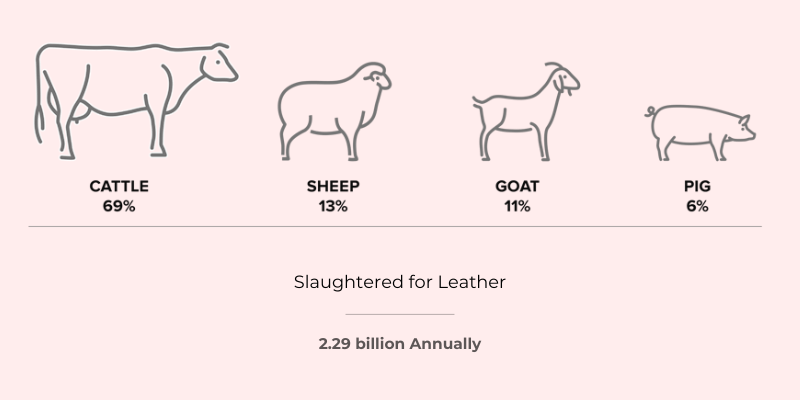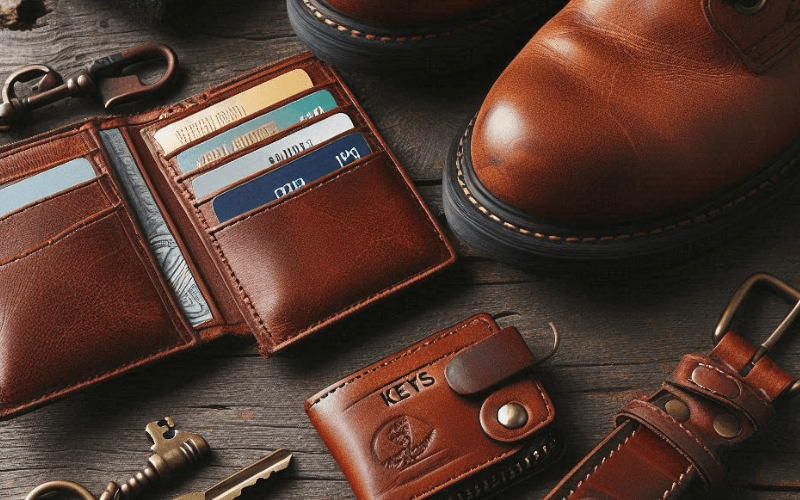In the realm of fashion, there’s a growing recognition of the harmful impacts linked with traditional leather, prompting more individuals to seek ethical and eco-friendly alternatives, such as vegan leather.
The conventional production of leather involves processes like animal slaughter, which contributes to water pollution, generates excessive waste, and emits greenhouse gases. Shockingly, each year, approximately 2.29 billion cows, calves, buffaloes, pigs, and goats are slaughtered to meet the demand for leather.
On the other hand, plant-based or vegan leather offers more than just a different fabric option; it provides benefits such as cruelty-free production and a reduced environmental footprint.
In this blog post, we’ll explore the what is vegan leather, its advantages, the materials it’s made from, and much more.
What is Vegan or Faux Leather?
First, let’s uncover the reality behind traditional leather.
Traditional Leather
Most leather comes from animal hides, usually obtained after the animals are killed. Sometimes, though, the skinning happens while the animals are still alive. The process of turning these raw hides into leather is called tanning.

The primary animals used for producing conventional leather include cattle (69%), sheep (13%), goats (11%), and pigs (6%).
What is Vegan Leather?
Vegan leather, or faux leather, is created from materials like PU, PVC, cork, pineapple leaves, corn, apple peels, and mushrooms. It provides a genuine alternative to traditional leather, without using any animal hides.
More and more people concerned about animal welfare and the environment are choosing cruelty-free leather instead of traditional leather options.
What is Vegan Leather Made of?

Vegan leather comes in various materials, broadly categorized as synthetic and natural plant-based options.
A. Synthetic Materials:
Polyurethane (PU) and polyvinyl chloride (PVC) are the main synthetic materials used for making cruelty-free or vegan leather.
Polyurethane (PU) and Polyvinyl Chloride (PVC): These are plastic materials that provide durability, affordability, and a leather-like texture.
PU is more flexible and breathable than PVC. However, their production, which relies on fossil fuels, has environmental drawbacks, such as slow decomposition in landfills.
Recyclable Materials: Vegan leather is increasingly made from recycled sources like Recycled Polyester (rPET) and Pre/Post-consumer PU Scraps, making it a sustainable choice for environmentally conscious consumers.
B. Natural Plant-Based Materials:
There is a growing trend of using plant-based materials for vegan leather, providing a sustainable alternative.
Cork: Harvested from cork oak trees, cork regenerates every 9-12 years. It is praised for its durability, water, and fire resistance, as well as its softness and suppleness, making it a viable alternative to plastic and animal-derived leather.
Cactus: Made from prickly pear cactus leaves, this leather has a low environmental impact, breathable, strong, and flexible.
Apple Peels: Innovative companies repurpose apple waste such as peels and cores to produce sustainable leather alternatives, reducing waste while offering durability and a unique aesthetic.
Pineapple Leaves: Utilizing leftover leaves from pineapple plantations, this vegan leather option offers rapid renewal, water-efficient production, and lightweight, breathable properties.
Ongoing research continues to discover new sustainable and cruelty-free sources for vegan leather production, highlighting its evolving nature.
Benefits of using Vegan Leather
Vegan leather offers a compelling and eco-friendly alternative to traditional leather, with several noteworthy benefits.
1) Ethical Considerations:
Unlike traditional leather, which involves the slaughter of millions of animals, vegan leather is cruelty-free, as it doesn’t use any animal-derived materials.
2) Environmental Benefits:
Traditional leather production is a significant contributor to greenhouse gas emissions and deforestation. In contrast, vegan leather production requires less land, water, and energy, reducing its environmental impact. Additionally, it uses fewer harmful chemicals and innovative, eco-friendly tanning methods.
Vegan leather is made from plant-based materials like cork, pineapple leaves (Piñatex), apple peels, and mushroom caps, as well as recycled materials.
3) Performance and Practicality:
Modern vegan leather is highly durable, resisting wear and tear similar to traditional leather. It’s also lightweight, and flexible, and comes in various colors, textures, and finishes. Moreover, it offers stain resistance, water resistance, and easy maintenance.
4) Cost-Effectiveness:
The production processes for vegan leather are generally more cost-effective than those for traditional leather, resulting in a lower price point for consumers.
Is Vegan Leather Good Quality?
Vegan leather made from Pinatex, Mushroom Leather, and High-Quality PU (Polyurethane) are some of the top-notch options.
To judge the quality of vegan leather, we should think about a few things that affect how long it lasts:
1. The material it’s made from
2. How you take care of it
3. How it’s put together
4. What kind of environment it’s used in
5. How thick it is
Vegan leather is generally a bit thinner and not quite as tough as regular leather, but if you look after it well, it can still last a long time.
Is Vegan Leather Durable?
The durability of vegan leather depends on a few important factors:
1. Variety of Materials: Vegan leather comes from various sources such as cork, pineapple leaves, corn, apple peels, and synthetics like PU, PVC, and mushrooms. Among these, PU-based vegan leather tends to last longer than traditional animal leather, though the durability of other options may vary.
2. Tensile Strength: This refers to how much force a material can take before tearing. Some types of vegan leather are stronger in this regard compared to animal leather.
3. Abrasion Resistance: This measures how well the material can withstand scratches. While animal leather usually performs better here, advances in vegan leather production have led to alternatives that hold up well against abrasion.
4. Cracking: Animal leather often cracks quickly if not maintained properly, whereas vegan leather, especially PU-based varieties, tends to resist cracking better over time.
To sum up, while not all vegan leather types are equally durable, PU-based options are generally quite sturdy. Additionally, ongoing innovations in vegan leather production offer hope for even better durability in various uses.
It’s important to note that how long vegan leather lasts also depends on how well it’s taken care of, with items like mobile cases potentially lasting longer than things like belts.
What is Vegan Leather used For?
Vegan leather has become a popular choice across various industries because of its versatility, serving as a sustainable substitute for traditional leather.
A) Vegan Leather Clothing & Accessories:
For clothing and accessories like handbags, backpacks, wallets, jackets, coats, pants, belts, and shoes, vegan leather is a top pick. It’s favored by those who care about animals and the environment, offering a chic and polished look similar to real leather.
B) Vegan Leather Furniture:
The furniture industry has warmly embraced vegan leather as a comfortable and stylish alternative to traditional leather. It’s a great option for those who prefer cruelty-free choices. Some types even boast stain resistance, making them perfect for sofas and dining chairs, especially in homes with pets.
Moreover, vegan leather is used in upholstery (sofas, chairs, ottomans), car interiors (covers, dashboards), and tech accessories (phone cases, laptop sleeves), among other applications.
Vegan Leather vs. Faux Leather
Vegan Leather and Faux Leather are synonymous terms used to describe leather not derived from animal skin. Faux leather (fake leather) mimics the appearance of genuine leather, focusing on its aesthetic appeal, while Vegan leather, also known as cruelty-free leather, appeals to consumers seeking ethically sourced materials without animal harm.
Vegan Leather vs. Real Leather
| Factors | Vegan Leather | Real Leather |
|---|---|---|
| Material Source | Vegan leather typically derives from plant-based materials like pineapple, cork, or apple peel, or from synthetics such as polyurethane or PVC. | Real leather originates from animal hides, including those of cows, sheep, or goats. |
| Durability | Offers less durability, higher-quality options can provide longer-lasting wear. Over time, some may experience cracking and peeling. | Real leather boasts greater durability, with less susceptibility to cracking and peeling over time. |
| Sustainability | More sustainable for the environment, whereas those sourced from plastic contribute less harm. | Not environmentally sustainable, as it generates greenhouse gases, waste, and harmful chemicals. |
| Animal Welfare | Production does not harm animals. | The production involves the slaughter of over 1 billion animals annually. |
| Cost | Faux leather tends to be more affordable than traditional leather. | More expensive compared to vegan alternatives. |
Conclusion
In summary, deciding to use vegan leather is a great way to address ethical and environmental concerns. While traditional leather may be a bit more durable, vegan leather offers numerous benefits and is getting even better with new innovations.
It’s important to understand that picking vegan leather helps reduce our carbon footprint compared to regular leather, and it does so without any harm to animals. Additionally, as more people choose vegan leather, it should become easier to find and more affordable.
To help others make informed decisions, it’s essential to share information about vegan leather. By spreading the word through platforms like this blog, we can encourage more people to embrace sustainable options and contribute to a kinder, greener future.
FAQ
Ans: Vegan leather shoes are not made from animal hides. Instead, they’re crafted from materials like cactus leather, polyurethane (PU), and microfiber, making them cruelty-free alternatives ideal for vegans.
Ans: You can find vegan leather options from numerous brands, making them readily available for purchase.
Ans: Not all vegan leather types are waterproof. However, PU leather tends to be more water-resistant than other varieties. If waterproofing is important to you, be sure to check the product label before buying.
Ans: Yes, some types of vegan leather, such as those made from cork, pineapple leaves, corn, apple peels, and mushrooms, are more sustainable than traditional leathers like PU and PVC.
Ans: No, vegan leather imitates the appearance and texture of traditional leather without using any animal by-products. It’s worth noting that vegan leather does not involve the use of animal-derived materials.

Andy, the vegan activist, is profoundly enthusiastic about witnessing a world devoid of all forms of cruelty and brimming with love for one another. read more…


Leave a Reply